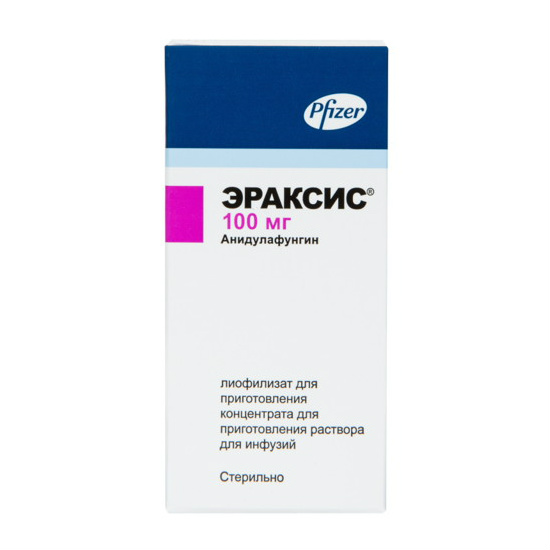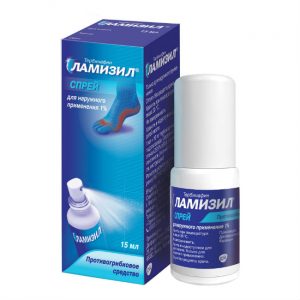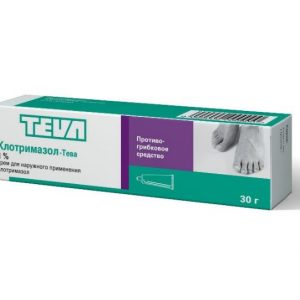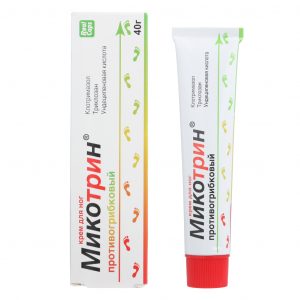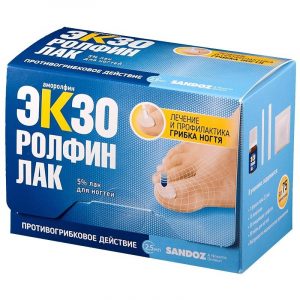Description
Release form
Lyophilisate for preparation of solution for infusion
Pharmacological action
Eraxis – antifungal agent, semi-synthetic echinocandin, lipopeptide synthesized by fermentation of Aspergillus nidulans products. Anidulafungin selectively inhibits the synthesis of 1,3 – D glucan, an important enzyme of fungal cells that is absent in mammalian cells. This leads to impaired formation of 1,3 – D-glucan, the main component of the fungal cell wall.
Anidulafungin is a semi-synthetic echinocandin, a lipopeptide synthesized from the fermentation product of Aspergillus nidulans.
Anidulafungin selectively inhibits 1.3 – D glycan synthetase, an important component of the fungal cell wall. In mammalian cells, 1.3 – D glycan synthetase is absent. It was established that anidulafungin has fungicidal activity against Candida spp. And also inhibits the cell growth of Aspergillus fumigatus.
In vitro activity
Candida spp., including C. albicans, C. glabrata, C. krusei, C. parapsilosis, C. tropicalis, C. dubliniensis, C. lusitaniae and C. guilliermondii, and Aspergillus spp., are sensitive to anidulafungin. including A. fumigatus, A. flavus, A. niger and A. terreus. Anidulafungin is active against pathogens of mycoses, resistant to antifungal drugs of other classes.
MICs were determined by the standard CLSI M27 method for yeast. The relationship between the activity of anidulafungin in vitro and the clinical result has not been established.
In vivo activity
In an experiment, anidulafungin administered parenterally was effective against Candida spp. both with normal and impaired immunity. Treatment with anidulafungin increased survival and also reduced Candida spp. organ damage. In the experiment, disseminated infections caused by C. albicans, fluconazole-resistant esophageal / oral candidiasis caused by C. albicans, and fluconazole-resistant disseminated infections caused by C. glabrata developed against neutropenia were simulated. Anidulafungin was also effective in experimental aspergillosis, caused by Aspergillus fumigatus.
Combination with other antifungal drugs
In vitro studies have shown that anidulafungin in combination with fluconazole, itraconazole and amphotericin B is not an antagonist of these drugs against Candida spp strains. The clinical significance of these results is unknown.
In vitro studies evaluated the sensitivity of Aspergillus spp. to anidulafungin in combination with itraconazole, voriconazole and amphotericin B. The combination of anidulafungin and amphotericin B showed no
interaction between the drugs in 16 of 26 isolates, while in 18 of 26 isolates synergism was observed when a combination of anidulafungin with itraconazole or in itoron. The clinical significance of these results is unknown.
Resistance mechanisms
Since the criteria for the interpretation of IPC parameters are not known for echinocandin class drugs, a significant increase in IPC may indicate potential resistance of the isolate. Clinical studies of isolates did not reveal an increase in BMD of anidulafungin. Resistance was also not revealed either in in vitro experiments or in studies on experimental models. Among isolates with elevated BMD values for echinocandins, only one isolate showed a mutation in the gene encoding the target 1.3 – D-glucan synthetase. Thus, the absence of complete cross-resistance between echinocandins was demonstrated.
Pharmacokinetics
General pharmacokinetic characteristics of
Anidulafungin, once administered, has linear pharmacokinetics over a wide range of daily doses (15 mg to 130 mg).
AUC variability coefficient for healthy volunteers, patients, and in special patient groups of the study was about 25%. The equilibrium state was reached on the first day after taking a saturating dose (doubled maintenance dose).
Distribution
Anidulafungin is rapidly distributed in body tissues (half-absorption time is about 0.5-1 hours). Vd is about 30-50 liters, which is approximately equal to the total volume of fluid in the body. Anidulafungin is largely associated with plasma proteins (degree of binding> 99%).
Metabolism
Metabolism of anidulafungin in the liver has not been established. Since anidulafungin is not a clinically significant substrate, inducer or inhibitor of P450 cytochrome isoenzymes, it is unlikely that anidulafungin has a clinically significant effect on the metabolism of drugs that occurs with the participation of the P450 cytochrome system.
At physiological temperatures and pH, anidulafungin undergoes slow chemical degradation, turning into an open-ring peptide lacking antifungal activity. The half-life of anidulafungin under physiological conditions is approximately 24 hours. In vivo, the open-ring peptide is sequentially cleaved into other peptides and eliminated mainly by excretion with bile.
Excretion
The clearance of anidulafungin is about 1 l / h. T1 / 2 is about 24 hours, and terminal T1 / 2 is 40-50 hours.
In a clinical study in healthy volunteers using a single dose (about 88 mg) of radioactive isotope-labeled carbon (14C) anidulafungin, it was found that about 30% of the administered dose was eliminated by the intestine within 9 days, with the fraction of the unchanged product being less than 10%. Less than 1% of the administered labeled drug was excreted by the kidneys. 6 days after taking the drug, the concentrations of anidulafungin decreased below the limit of determination. 8 weeks after taking the drug, its concentrations in the blood, urine and feces were negligible.
Special patient groups
Patients with fungal infections
According to population pharmacokinetic analysis, the pharmacokinetics of anidulafungin in patients with fungal infections are similar to those in healthy individuals. In the range of daily doses from 100 mg to 200 mg and at an infusion rate of 1 mg / min, Cmax and Cmin are about 7 mg / L and 3 mg / L, respectively, and the average equilibrium AUC is about 110 mg * h / L.
Weight
The weight of the patient has virtually no effect on the pharmacokinetics of anidulafungin.
Gender
Concentrations of anidulafungin in the blood plasma of healthy men and women were similar. In studies using several doses of anidulafungin, it was shown that in men, the clearance of anidulafungin is somewhat accelerated (approximately 22%).
Elderly patients
In the elderly (patients aged 65 years, average clearance 1. 07 l / h) according to population pharmacokinetic analysis, the average clearance of anidulafungin is somewhat different from that in other age groups (patients aged
racial affiliation
The pharmacokinetics of anidulafungin were similar in people of the European race, Negroid race, as well as immigrants from Asia and Latin America.
HIV-infected patients
Dose adjustment is not required in HIV-infected patients with various types of antiretroviral therapy
Lack of liver function
Anidulafungin not me aboliziruetsya in the liver. anidulafungin concentration in the blood plasma of patients with hepatic failure of any patient (classes A, B and C Child-Pugh classification) is not increased. Although patients with severe hepatic impairment (Child-Pugh class C) showed a slight decrease in AUC, it did not go beyond the values of healthy volunteers.
Insufficiency of renal function
Anidulafungin is practically not excreted by the kidneys (clearance
Children
The pharmacokinetics of anidulafungin was studied in 24 immunocompromised children (2 to 11 years old) and adolescents (12 to 17 years old) with symptoms of neutropenia. saturating dose (or doubled maintenance dose), and the equilibrium Cmax and AUCss increased in a dose-dependent order After administration of the drug in daily maintenance doses of 0.75 mg / kg / day and 1. 5 mg / kg / day for children aged 2 to 17 years, systemic indicators were comparable to those in adults with the introduction of the drug in doses of 50 mg / day and 100 mg / day, respectively.
Indications
Invasive candidiasis in adults without neutropenia.
Contraindications
Hypersensitivity to anidulafungin and other echinocandin drugs.
Use during pregnancy and lactation
Anidulafungin should not be used during pregnancy.
It is not known whether anidulafungin with breast milk is excreted in humans. If it is necessary to use anidulafungin during lactation, breastfeeding should be discontinued.
Experimental animal studies have shown that anidulafungin is excreted in breast milk.
Composition
1 vial contains:
Active ingredient: anidulafungin 100 mg.
Dosage and administration of
Before starting therapy, seed culture and other laboratory tests (including histological examination) should be obtained to isolate and identify the causative agent. Treatment can be started before laboratory results are obtained. However, after obtaining these results, antifungal therapy should be adjusted.
The drug Eraxis is administered iv. The infusion rate should not exceed 1.1 mg / min, which is equivalent to 1.4 ml / min for a dosage of 100 mg.
Minimum infusion duration is 90 minutes.
Invasive candidiasis, including candidiasis
On the first day, the drug Eraxis is administered once at a dose of 200 mg, then at a dose of 100 mg / day. The duration of treatment depends on the clinical response of the patient. Antifungal therapy should be continued for at least 14 days after the disappearance of the symptoms of infection and the eradication of the pathogen.
Esophageal candidiasis
On the first day, Eraxis is administered once at a dose of 100 mg, then at a dose of 50 mg / day. The duration of treatment depends on the clinical response of the patient and is at least 14 days, and at least 7 days after the disappearance of the symptoms of infection. If there is a risk of recurrence of esophageal candidiasis in patients with HIV infection, the need for anti-relapse antifungal therapy should be determined after treatment with anidulafungin.
Instructions for the preparation of an infusion solution
The drug Eraxis is available in single-use vials.
Eraxis should be reconstituted with water for injection and then diluted with only 0.9% sodium chloride solution for infusion or 5% glucose solution for infusion.
WARNING: The compatibility of reduced anidulafungin with other drugs for iv administration, as well as with solutions, is unknown.
Restoration of
Under aseptic conditions, 30 ml of water for injection is added to the vial to give a solution containing anidulafungin at a concentration of about 3.33 mg / ml.
The solution should be colorless and transparent and should not contain visible particles.
When detecting visible particles and / or visible staining, the solution should be destroyed.
The reconstituted solution should be used within 1 h.
Dilution and infusion
Under aseptic conditions, the reconstituted solution is transferred from the vial to the infusion bag (or vial) containing 0.9% sodium chloride solution for infusion or 5% glucose solution for infusion to achieve the required concentration anidulafungin. The table below shows the required volumes of solution and solvent, as well as the rate of infusion and the minimum duration of infusion.
The ready-made infusion solution should be used within 24 hours.
If the infusion solution is not used immediately after preparation, it should be stored at a temperature of 2 to 8 ° C.
Drug Interaction
Anidulafungin is not an inducer or inhibitor of cytochrome P450 isoenzymes (1A2, 2B6, 2C8, 2C9, 2C19, 2D6, 3A). It should be noted that in vitro studies do not rule out possible interaction under in vivo conditions.
Storage Conditions
At 8-22 ° C.
Shelf life
3 years
Deystvuyushtee substance
Anidulafungin
dosage form
infusion solution
Possible product names
ERAXIS 0.1 N1 FLAC LIOF D / END D / R-RA D / INF
Eraxis 100 mg No. 1 fl
Eraxis lyof d / con d / inf 100mg fl N1 srdlofp Erax . solution for infusion 100 mg vials 1 pc.
Eraxis vial, 100 mg
